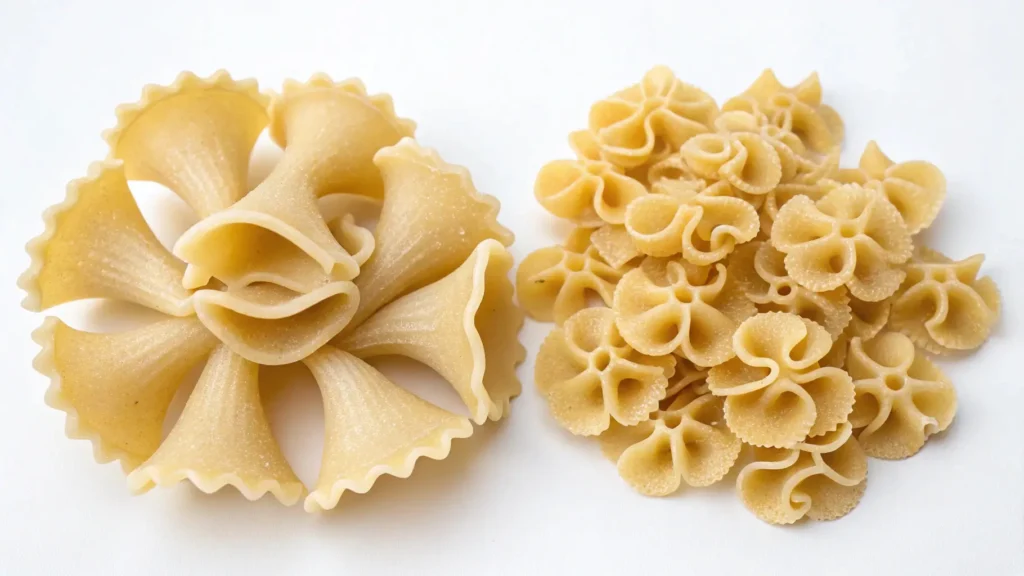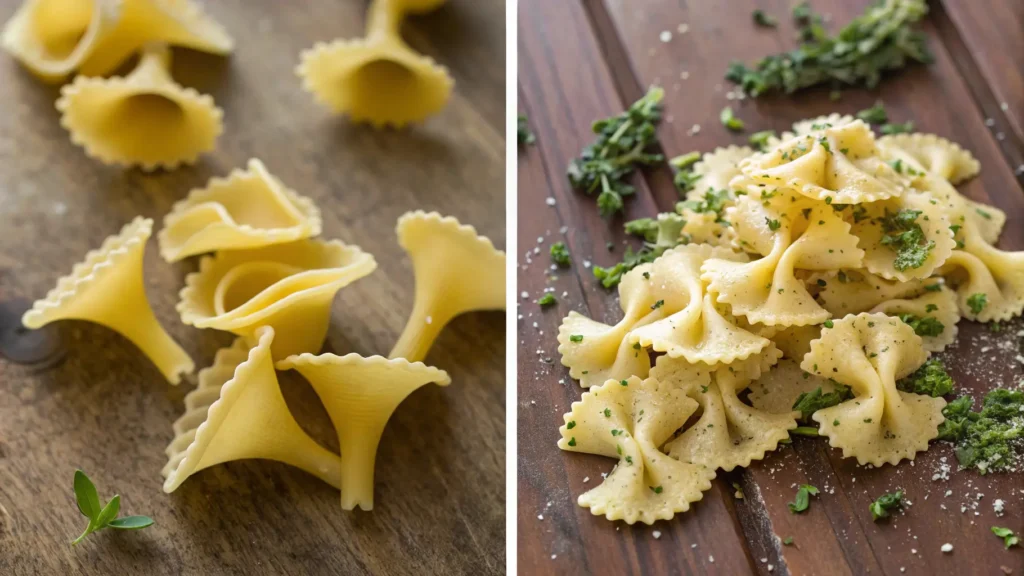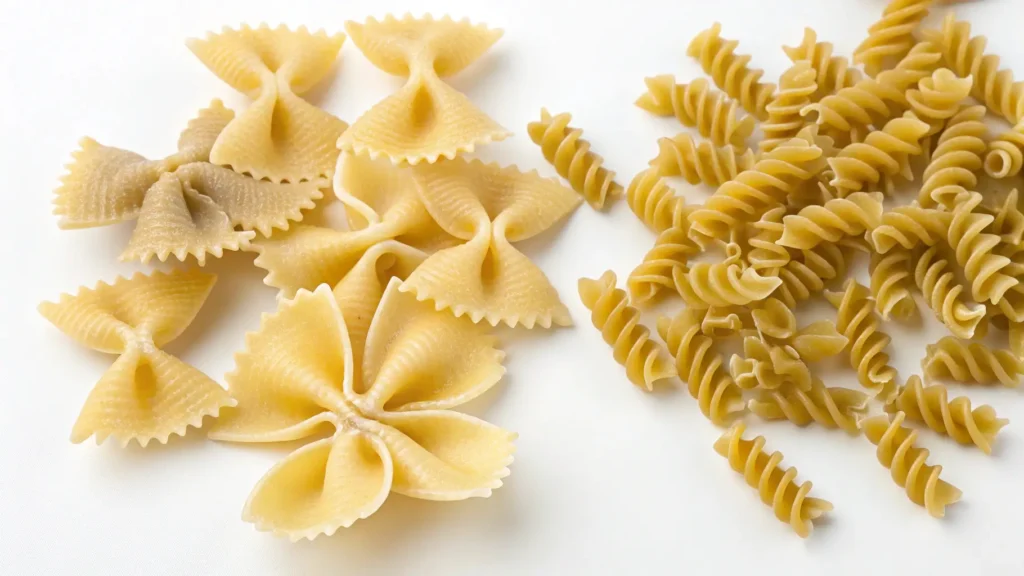Pasta is not just food; it’s a celebration of culture, creativity, and culinary artistry. Among the countless varieties, gigli and campanelle stand out for their distinctive shapes and textures. This article will explore what makes these two pasta types unique, delving into their origins, uses, and differences. By the end, you’ll not only understand the answer to the question “What is the difference between gigli and campanelle?” but also gain inspiration for crafting memorable dishes with these delightful pasta shapes.

Part 1: Introduction to Pasta Varieties (250 Words)
The Fascination with Pasta Shapes
Pasta is one of the most versatile foods globally, with shapes ranging from simple spaghetti strands to intricate designs like farfalle and orecchiette. Every shape has its own story and purpose, designed to complement certain sauces and cooking techniques. The variety is not merely aesthetic; it’s deeply functional and cultural, offering endless opportunities to experiment and savor.
Why Gigli and Campanelle Stand Out
Among the multitude of pasta types, gigli and campanelle capture attention due to their unique shapes and Italian heritage. Gigli, also known as “lilies,” resembles a blooming flower, while Campanelle, meaning “little bell,” mirrors the form of a bell or cone with wavy edges. These two types aren’t just visually appealing—they also provide specific textural and culinary advantages that set them apart from one another.
Both pasta types hail from Italy and are prized for their ability to hold sauces beautifully. While they may seem similar to the untrained eye, their subtle differences make them suited to distinct recipes. Understanding their nuances is key to mastering their use in cooking, and that’s exactly what we’ll unravel in this guide.
Part 2: What is Gigli Pasta? (300 Words)
Origin and History of Gigli Pasta
Gigli, which means “lilies” in Italian, is a pasta shape inspired by the iconic flower associated with Florence. This connection to Tuscan heritage gives it a rich cultural backdrop. Originally crafted as a symbol of beauty and sophistication, gigli pasta is often linked to traditional Italian feasts and celebrations.
Its history reflects Italy’s passion for blending artistry with gastronomy. Over the years, gigli has remained a beloved choice, not just for its visual appeal but also for its ability to adapt to various dishes.
Distinctive Shape and Texture
Gigli pasta is instantly recognizable due to its delicate, fluted edges and flower-like design. This intricate structure is not merely ornamental—it serves a practical purpose. The ridges and folds are excellent at trapping hearty sauces, creamy blends, and even small bits of vegetables or meat.
Unlike smoother pastas like penne, gigli has a slightly chewy texture that holds up well in baked dishes. Its versatility makes it perfect for casseroles, pasta salads, and thick ragus.
Common Uses and Recipes Featuring Gigli
From creamy Alfredo sauces to robust tomato-based gravies, gigli thrives in a wide array of recipes. It’s often paired with rich, chunky sauces that complement its shape. Want a Tuscan twist? Use gigli in a baked pasta dish with béchamel sauce, sausage, and spinach.
In the culinary debate on what is the difference between gigli and campanelle?, gigli stands out for its elegant form and adaptability. It’s a pasta that invites creativity, transforming simple ingredients into gourmet experiences.
Part 3: What is Campanelle Pasta? (300 Words)
Cultural Roots and Naming of Campanelle
Campanelle, meaning “little bell” in Italian, takes its name from its bell-like shape. This pasta hails from central and southern Italy, regions renowned for their rich culinary traditions. Its unique design pays homage to the craftsmanship of pasta-making, where form and function go hand in hand.
Historically, campanelle was reserved for special occasions, symbolizing joy and festivity. Today, it’s a staple in both casual and upscale dining, loved for its versatility and distinctive charm.
Recognizing Campanelle’s Bell-Like Form
Campanelle pasta is shaped like a tiny cone with frilly edges that curl outward, resembling the petals of a bellflower. Its compact structure makes it an excellent choice for holding sauces, whether creamy, chunky, or oil-based.
The texture is firm yet tender, providing a satisfying bite. This makes it ideal for hearty dishes where the pasta’s integrity matters, such as casseroles or pasta primavera.
Popular Recipes and Pairings
Campanelle pairs beautifully with lighter sauces, such as pesto or garlic and olive oil, that highlight its delicate shape. It’s also a great match for seafood dishes, where the frilly edges capture every bit of sauce and flavor.
For a comforting meal, try campanelle with a creamy Alfredo sauce, peas, and crispy pancetta. Or, embrace its Italian roots by pairing it with a sun-dried tomato and basil sauce.
When considering what is the difference between gigli and campanelle?, campanelle is often preferred for its slightly larger size and broader compatibility with lighter, fresher sauces. Its shape and texture make it a star in modern kitchens, balancing style with substance.
Part 4: Comparing Gigli and Campanelle (400 Words)

Shape and Structural Differences
When it comes to what is the difference between gigli and campanelle?, the first noticeable factor is their shape. Gigli is designed like a delicate flower with fluted edges, while campanelle resembles a small, bell-like cone with ruffled sides. These distinctions not only influence their appearance but also their ability to hold different types of sauces.
Gigli’s tighter folds make it perfect for thicker, chunkier sauces, as it traps bits of meat or vegetables in its crevices. In contrast, campanelle’s broader and slightly looser structure is more accommodating to lighter, oil-based, or creamy sauces, offering a balanced bite.
Texture Variations and Cooking Techniques
Texture plays a significant role in how these pasta shapes perform in recipes. Gigli, with its dense and chewy texture, holds up well in baked dishes and slow-cooked recipes. Campanelle, on the other hand, is slightly softer and more pliable, making it ideal for salads and stovetop preparations.
Both pastas shine when cooked al dente, but their unique structures might require slight adjustments in boiling time to achieve optimal results. Experimenting with their textures allows chefs to craft dishes that bring out the best of their features.
Which Sauce Works Best for Each?
Pairing pasta with the right sauce is an art. Gigli pairs beautifully with robust sauces like Bolognese or a spicy arrabbiata, as its folds cradle every drop of flavor. Campanelle thrives in recipes that emphasize freshness, such as a pesto or a light lemon-butter sauce, where its airy form lets the sauce coat evenly without overwhelming.
For additional pasta pairing ideas, check out The Ultimate Guide to Gigli Pasta on Tangle Recipes.
Part 5: Nutritional Aspects of Gigli and Campanelle (200 Words)

Nutritional Profile of Gigli
Gigli pasta is typically made from durum wheat semolina, providing a healthy dose of complex carbohydrates, fiber, and some protein. The exact nutritional value depends on whether it’s made from enriched flour or includes additives like spinach or tomato for color and flavor.
Health Benefits of Campanelle
Campanelle offers similar nutritional benefits, being a great source of sustained energy and essential nutrients. For health-conscious diners, whole wheat or gluten-free versions of campanelle are readily available, offering additional fiber and lower calorie options.
Comparative Analysis of Nutritional Value
While both pastas are nutritionally similar, their compatibility with different sauces can influence the overall calorie and nutrient content of the dish. Gigli’s preference for hearty sauces might result in a heavier meal, while campanelle’s affinity for lighter sauces can be part of a more balanced, calorie-conscious dish.
Whether you’re aiming for indulgence or health, both gigli and campanelle can be tailored to meet your dietary goals. For more pasta-related health insights, you can explore Lumache Pasta Recipes and Tips for inspiration.
Part 6: FAQs on Gigli and Campanelle (250 Words)
Are Gigli and Campanelle Interchangeable?
A common question for pasta enthusiasts is whether gigli and campanelle can be swapped in recipes. The short answer is yes—but with some caveats. Their shapes and textures mean they work better with specific sauces. Gigli’s intricate folds make it ideal for chunky, hearty sauces, while campanelle’s open structure shines with lighter, creamier options.
When considering what is the difference between gigli and campanelle?, this adaptability is key. While you can substitute one for the other, the dish’s flavor and texture might feel slightly different depending on the sauce.
Which Pasta is More Versatile?
Both gigli and campanelle are highly versatile, but campanelle might have a slight edge due to its broader compatibility with a variety of sauces. It works beautifully in everything from cold pasta salads to warm, creamy dishes. Gigli, though slightly more specialized, is perfect for baked dishes and thick ragus that demand a sturdy shape.
What Are Some Alternatives for Each Pasta?
If neither gigli nor campanelle is available, other pasta shapes can serve as substitutes. Fusilli, with its spiral design, mimics the sauce-gripping ability of gigli. Similarly, shells or penne can stand in for campanelle due to their capacity to hold sauce. When experimenting with alternatives, it’s important to remember the sauce’s consistency and how it interacts with the pasta.
Part 7: Creative Uses for Gigli and Campanelle (150 Words)
Innovative Pasta Dishes with Gigli
Gigli’s shape lends itself to creative dishes. For an eye-catching presentation, try a baked gigli casserole layered with béchamel, roasted vegetables, and melted cheese. Alternatively, use it in a hearty soup where its sturdy structure can hold up to prolonged cooking.
Unexpected Recipes Using Campanelle
Campanelle’s unique design is perfect for more unconventional recipes. Toss it with fresh pesto, cherry tomatoes, and mozzarella for a refreshing pasta salad, or use it in a creamy carbonara to let its frilly edges soak up every bit of sauce. Its airy form also makes it an excellent addition to seafood dishes, where the lightness of the sauce complements its texture.
In both cases, these pasta shapes offer endless possibilities to elevate everyday recipes. When exploring what is the difference between gigli and campanelle?, creativity in the kitchen can turn either into the centerpiece of your meal.
Part 8: Conclusion (100 Words)
Celebrating the Diversity of Pasta
When it comes to what is the difference between gigli and campanelle?, their unique shapes, textures, and culinary uses highlight the beauty of pasta diversity. Gigli captivates with its flower-like elegance, excelling in hearty and baked dishes, while campanelle charms with its bell-shaped versatility, perfect for light and creamy sauces.
These differences make each pasta special, offering endless opportunities for creativity in the kitchen. Whether you’re preparing a comforting casserole or a vibrant pasta salad, understanding these distinctions helps you elevate your cooking and bring authentic Italian flavors to your table.

